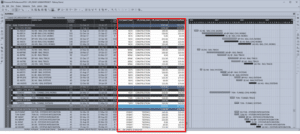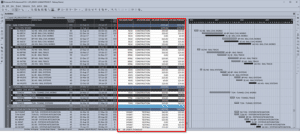Mahdi Shahsavand
Project or portfolio decisions are made by different levels of management. Managers at the strategic levels establish priorities and resources to move toward organizational goals. There is also an operational level to manage day-by-day activities, allocate resources and plan for the near future. Between these two levels, tactical management focuses on project selection and resource capacity management. Considering the difference in the scope and nature of their responsibilities, executive and senior managers need less detailed information compared to the project execution managers (figure 1).

The project schedule is a crucial information source for proper decision-making. It is an excellent tool for managing the project’s time, scope, and resources and communicating all the necessary information to the stakeholders. The concept of multi-level scheduling comes from having schedules with different levels of detail to suit the requirements of all management groups.
A multi-level schedule is crucial for managing programs or projects with multiple contracts and sub-projects. It is intended to have a high-level plan representing the relations between different project components. Wherein the high-level dates are determined by rolling up the lower levels. This schedule can show the impact of the delay or expedition of one contract on other contracts and final project completion (figure 2). Without this structure, the project management team can be easily misguided about the project status and miss critical time to decide on the project path forward.

Multi-level schedule
Conventionally the schedule levels often correlate with the project’s Work Breakdown Structure (WBS). The number of levels in a schedule is determined based on project specifications and stakeholders’ needs. However, the following describes the general specifications of different levels in a schedule: Level 0 Level 0 consists of the program/project key milestones and summary activities by major phases, scopes, or projects. Level 0 schedules provide high-level information for strategic decision-making (project selection and prioritization). Audiences for this schedule level include but are not limited to clients, senior executives, and general managers. If included with a bid or the contract, it demonstrates conformance with contractual and other milestones.
Level 1
The level 1 schedule provides a high-level project management summary. It is generally prepared to ensure and communicate the integration of work throughout the project’s life cycle. In addition, level 1 schedules show interfaces between key deliverables and contracts. Audiences for this level of the schedule include but are not limited to general managers, sponsors, and program or project managers.
Level 2
Level 2 schedules are the major planning and scheduling documents for program/project coordination and control. Level 2 schedules are used to communicate the execution of the deliverables for each of the contracting parties. They can use this information to mitigate risks and prepare corrective actions. Audiences of this type of schedule include but are not limited to program or project management.
Level 3
Level 3 schedules contain the work packages for each contract phase or stage. A level 3 schedule is used to track the overall schedule status of the project. Level 3 provides enough detail to identify critical activities and should assist the project team in identifying activities that could potentially affect the outcome of the program or project. The owner updates this level based on the contractor’s detailed level 4 schedules. Audiences for this level of the schedule include but are not limited to project managers, owners’ representatives and cost controllers.
Level 4
Level 4 schedules are detailed project schedules in which work packages are broken down into detailed activities, mainly prepared by the contractors performing the work. Level 4 schedules are considered working schedules that reflect daily or weekly work requirements. Audiences of this level of the schedule include but are not limited to project managers, project coordinators, superintendents and general foremen. Level 4 schedules must be precisely aligned with higher-level schedules maintained by the owner. Therefore, a level 4 schedule should use the same WBS as the owner’s higher-level schedules.
All program or project schedule levels should be aligned so that higher-level dates are rolled up from a more detailed scope of activities. Figure 3 shows the schedule levels hierarchy.

Multi-level scheduling is an excellent technique when there are many contractors executing a project. The contractors utilize the detailed schedule while the owner performs project management at Levels 0, 1, 2, and 3. In this structure, the owner is not overwhelmed by unnecessary details of the contractors’ schedule and can control the project at a proper level. When the contractor’s detailed schedule and the owner’s high-level schedule are integrated and aligned, any changes in the detailed schedule are rolled up to the higher level. Therefore, the owner only reacts to the events that change the high-level activities timeline.
Multi-level scheduling can also be used in Rolling Wave Planning. It is impractical to plan all sections and phases at the onset of a project. Therefore, immediate and current phases should have schedules with more details (i.e. Level 4), while the future phase schedules will have fewer details. As the project moves into subsequent phases and the scope is more defined and confirmed, the required schedule details are increased to reflect the improved scope definition. For instance, a project entering the definition phase requires a level 3 detailed schedule for the engineering work, but the construction and commissioning work might only be detailed at level 1 or 2. In this technique, the schedule still includes the later phases and can predict the project completion date. Once the engineering phase progresses enough and the scope of the later phases is confirmed, more detailed activities are added under the high-level activities.
We at PM ERA are ready to help you to define and establish all the required processes and procedures for Multi-Level Scheduling within your organization.




